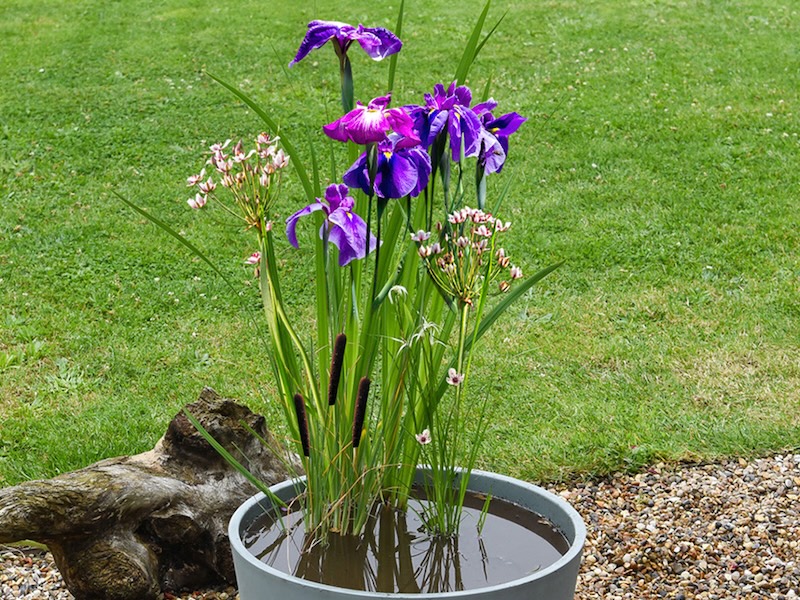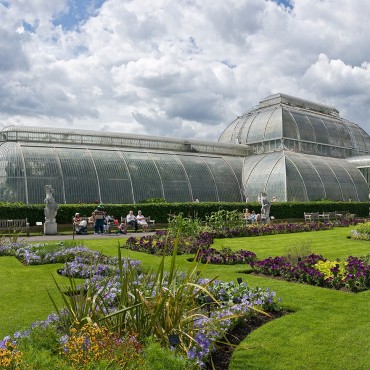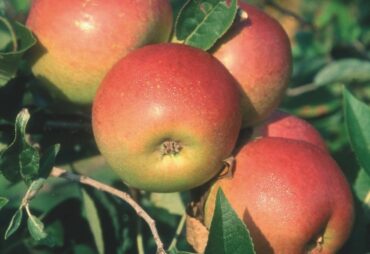Adding a small pool of water to your garden is one of the best ways of supporting biodiversity. It provides water, food, shelter, and breeding sites for so many different animals, from insects and amphibians to birds and mammals. It doesn’t matter if your garden is urban or rural, a water source will attract wildlife and the benefits are numerous. Here, expert organic gardener and author Sally Morgan explains how to create a micro pond from an upcycled container.
Browse our collection of pond plants for inspiration.
What are the benefits of a micro pond?
You don’t need to find space for a large pond in your garden. A micro pond created from a large container is just as beneficial. Here are just some of the reasons:
- Provides an important source of drinking water for birds, mammals, amphibians and insects.
- Offers a source of water during dry spells when natural water sources are scarce.
- Creates breeding sites for frogs, toads and newts.
- Attracts essential pollinators, such as bees, butterflies and hoverflies.
- Brings in predatory insects like dragonflies and damselflies.
- Enhances natural pest control, as the frogs, toads and birds that visit then feed on slugs, aphids, midges, mosquitoes and more.
- Can attract bats which hunt the mosquitoes and moths that are drawn to the pond.
Where should a micro pond be placed?
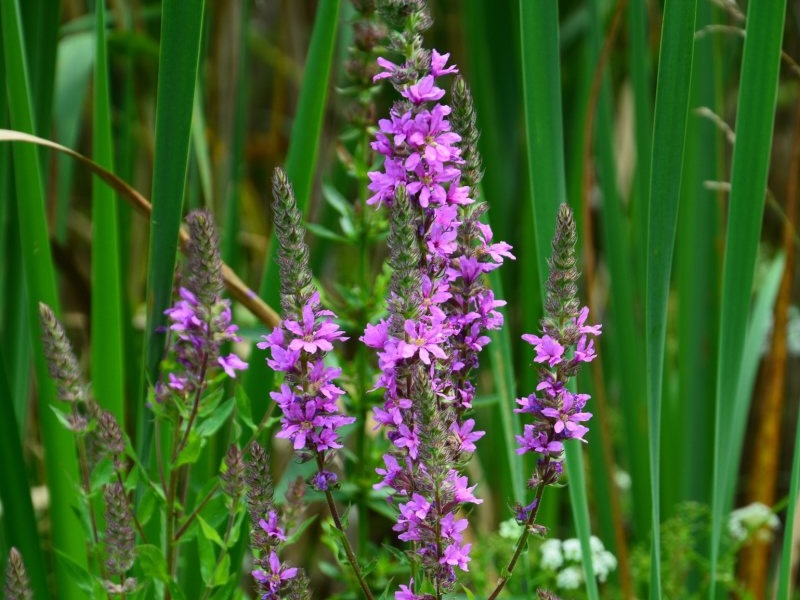
These tall spikes of rose-pink flowers are especially attractive to pollinators
Image: Lythrum salicaria (Marginal Aquatic) from Suttons
Even the smallest of gardens has space for a micro pond, and don’t forget that the perfect spot might also be in your front garden! The best place for a micro pond is a bright area that isn’t in the sun all day. Ideally it should be placed in a partial shady corner of a patio or buried partially or fully in the ground, making it easier for animals such as amphibians and hedgehogs to access.
Almost any watertight container can be used, including old Belfast sinks, galvanised baths or black plastic tubs (like a repurposed livestock water trough). To avoid the need for a liner, check your container is truly watertight. Ideally, it should have a minimum diameter of 60-70cm and a depth of 40-50cm to provide a stable environment.
Don’t forget to give your container a good clean before you fill it with water. Ideally, you should use rain water, but tap water is fine so long as you leave it for a couple of days for any chlorine in the water to dissipate.
What are the best plants for a micro pond?
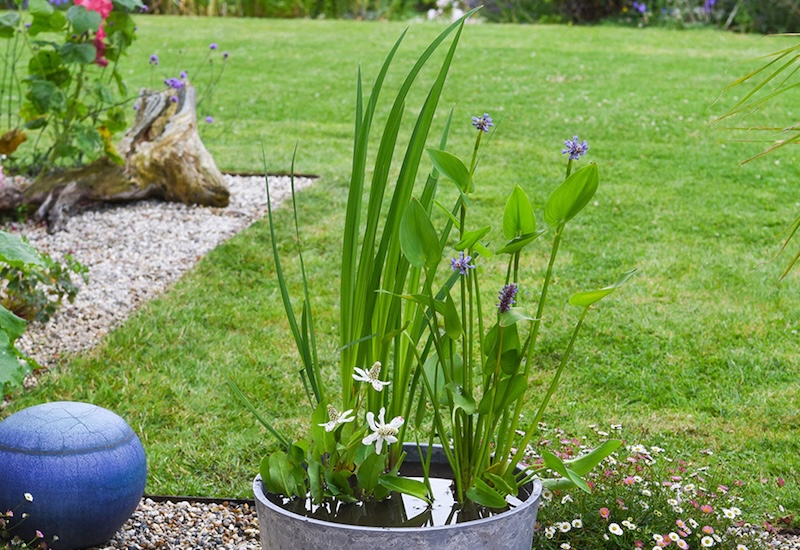
This convenient pod kit contains three striking pond plants and a planting basket
Image: Flowering pond kit from Suttons
Small ponds don’t have much space for lots of plants, so don’t get too carried away. I like to include:
- A miniature water lily (Nymphaea ‘Pygmaea ‘Helvola’) and for this to thrive the water needs to be 30-40 cm deep.
- A couple of oxygenators, such as starwort (Callitriche stagnalis) and hornwort (Ceratophyllum demersum). Not only will they provide oxygen, but they will shade the water and reduce the growth of algae, plus create hiding places for insects and amphibians.
- A few marginals around the edge. Remember these plants don’t want to be submerged but need to be planted in shallow water, so you will have to create a shelf using bricks or rocks. There’s a wide choice available such as lesser spearwort (Ranunculus flammula), marsh marigold (Caltha palustris), flowering rush (Butomus umbellatus) and the flag iris (Iris pseudocorus).
How to plant up your micro pond
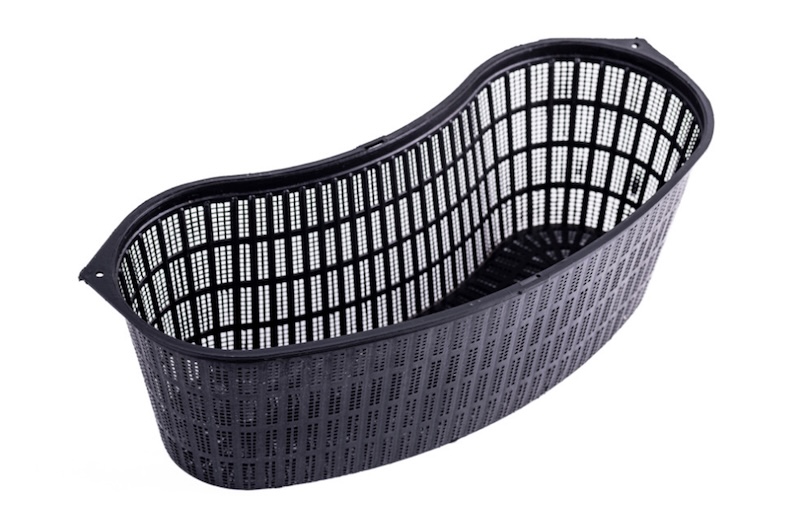
Use pond baskets to submerge plants in your container pond
Image: Oval Contour Aquatic Planting Basket from Suttons
You can’t drop plants like water lilies and marginals straight into the pond. They need to be transferred to an aquatic basket to ensure their roots have good contact with the water. Ideally you should avoid using garden compost and opt for a special aquatic compost as it’s denser and less likely to float away, plus it contains slow release fertilisers that reduce the risk of algae growth.
The basket for the water lily needs to be around 20cm in diameter, while larger baskets can usually accommodate 2 to 3 marginal plants. Transfer the plants into the appropriate-sized baskets and lower them into the water, using rocks and stones to secure them in place. With the water lily, don’t drop it to the bottom of your micro pond in one go, but lower it halfway and support it in place for a few days and then lower to the bottom. Expect the water to get quite cloudy at first, but it will soon settle.
These are just small pools of water, so resist the temptation to add fish!
How to maintain your micro pond
Micro ponds are easy to set up and require little ongoing maintenance. Simply:
- Remove fallen leaves regularly to prevent them from decaying and affecting the quality of the water.
- Check for duckweed and algae in summer. Both can be removed easily by hand.
- Keep an eye on water levels, especially in hot weather and top up with rainwater if needed.
Creating a micro pond in a polytunnel
Having a micro pond in your polytunnel can be incredibly valuable when it comes to natural pest control. It can be as simple as a bucket, buried in a shady corner where the water will stay cool and not evaporate too quickly in summer. Just add a basket of mixed native marginal plants and create shallow edges with bricks or rocks so that insects and amphibians have easy access.
How to encourage drone-flies to your garden
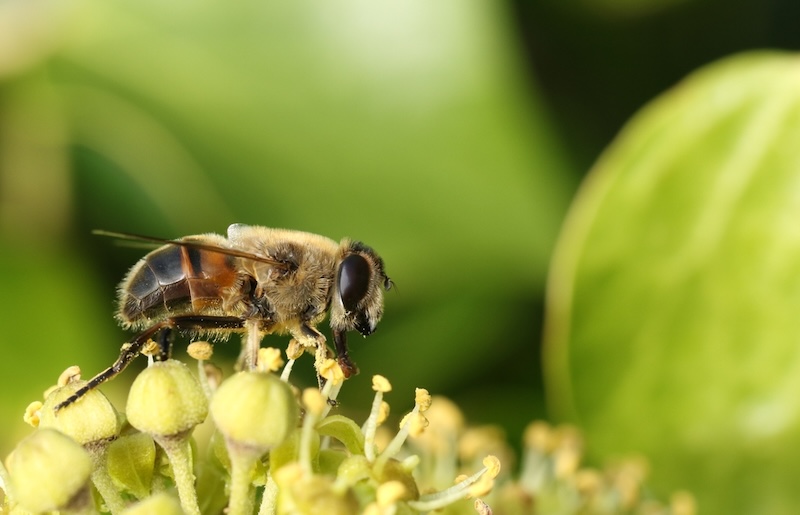
A Common Drone Fly, Eristalis tenax, pollinating an Ivy flower.
Image: shutterstock
The drone-fly (Eristalis tenax) is a fascinating hoverfly that mimics a honeybee. Active throughout the year, it emerges on warm days to feed on nectar, particularly from ivy flowers. Unlike most hoverflies, the female drone-fly lays her eggs in stagnant water and they hatch into larvae known as rat-tailed maggots! These remarkable larvae feed on decaying organic matter and are equipped with a long, snorkel-like breathing siphon, which is an adaptation to living in stagnant water. These larvae play a vital role in decomposing organic matter, while the adult is an important pollinator, so you really want to encourage drone-flies into your garden.
You can attract beneficial hoverflies into your garden by creating a pool of stagnant water. All you need is an old tub or bucket which you fill with decaying leaves and water. Place it in a shady, undisturbed area away from the house, and let it get smelly – the smellier the better. It will soon attract the attention of the female drone fly.
We hope this has given you plenty of ideas on how to create a small pond in any sized garden. Patio pond kits are an easy way to create a mini-water feature, but if you’re keen to try something bigger and more permanent, our best expert advice on how to create a wildlife pond is packed with useful tips.
Lead Image: Insects pond kit from Suttons
More about the author:
Sally Morgan is the author of The Resilient Garden and Allotment Handbook and Co-author of The Climate Change Garden. www.climatechangegarden.substack.com

